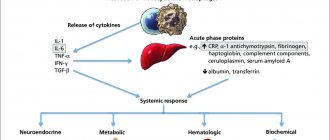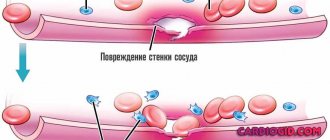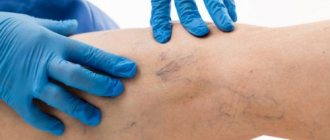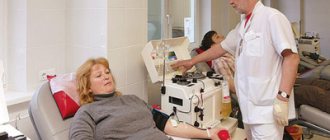This article can not only be read, but also listened to. If it's more convenient for you, turn on the podcast.
First, let's define the basics. Most often, icy limbs are normal. Feet and hands are always the first to get cold and the last to warm up. This is a necessary element of the survival mechanism.
When we enter a cold environment, the brain causes the blood vessels in the extremities to constrict. In this way, blood circulation in the periphery is limited, the blood cools less and helps retain heat in internal organs that are more important than the feet or palms.
However, sometimes it happens like this: it doesn’t seem to be too cold around, but your hands and feet are still icy and refuse to warm up. Here's what it might be connected with: Causes and remedies for cold feet.
Reason 1: sedentary lifestyle
With insufficient physical activity, the blood “stagnates” and poorly supplies the limbs with heat. The situation is further complicated by the fact that due to sedentary work the tone of the cardiovascular system decreases. Therefore, a person cannot warm up even after the end of the working day. Through weak vessels, blood practically does not reach the tips of the arms and legs.
What to do: every 2-3 hours you need to perform industrial gymnastics.
It is useful to take a contrast shower in the morning. The hardening procedure stimulates the heart and helps strengthen the walls of blood vessels.
My feet are cold: what to do?
So what should you do if such a misfortune occurs? To begin with, you should use simple recommendations to help warm your feet: use woolen socks, a heating pad or bottle of hot water, a knee-length bath with mustard or just warm water.
Long-term events look like this.
- It is imperative to quit smoking.
- You need to dress strictly in accordance with the weather conditions, avoiding tight clothing for the lower half of the body.
- Shoes must be chosen carefully and in size.
- Do regular exercise, such as exercise.
- Eat more protein foods, as well as various spicy foods, spices and seasonings, such as red pepper or mustard.
- Avoid any stress.
- It is advisable not to overuse strong tea or coffee. You need to drink tea with motherwort, mint, and valerian.
- If your feet are not only cold, but also sweaty, then it is advisable to take warming foot baths using sea salt or mustard. For example, salt baths are made as follows: in boiled, hot water, you need to dissolve two tablespoons of salt (sea salt, can be purchased at your nearest pharmacy), two tablespoons of milk. After the bath, you need to put on thick, woolen socks (knitted slippers are also an option).
- If you stand at work all day, then in the evening you need to arrange baths with the addition of mustard. This will improve blood circulation and relieve swelling.
- When even the slightest signs of freezing of the feet appear, it is necessary to massage them. First, rub the sole of each foot, then massage your toes. After this, put on warm socks (preferably pre-heated).
- There may be contraindications for the next procedure (for example, varicose veins). Prepare two containers with hot and cold water. You first need to place your feet in a container with warm water for 5-10 minutes, while doing a massage. Then your feet should be placed in cold water for 10-20 minutes. The procedure is repeated until the warm water cools down. Also, it must end with immersing your feet in cold water.
Reason 3: vitamin deficiency
Increased freezing can be caused by a lack of vitamins C, E and P. All these elements are responsible for maintaining the tone of the vascular walls. A deficiency of valuable compounds leads to vascular damage and circulatory failure. The condition is also accompanied by the frequent appearance of bruises on the body, fatigue, and pale skin. Pathology often develops in women on strict diets.
What to do: start taking multivitamins. Enrich your daily diet with fruits, vegetables and grains.
Reason 4: thyroid disease
The thyroid gland synthesizes hormones that control metabolism. Their deficiency leads to disruption of heat production. The patient's limbs become frozen, lethargy and depression occur. Additional signals of endocrine problems include a slow heartbeat, swelling of the eyelids, dryness and flaking of the skin.
What to do: visit an endocrinologist, get tested for thyroid-stimulating hormone and triiodothyronine, perform an ultrasound of the thyroid gland. If necessary, the doctor may prescribe additional tests: MRI, computed tomography, radiography.
Gymnastics
As mentioned above, exercise can help get rid of cold feet. Below we will consider a set of gymnastic exercises aimed specifically at the problem of cold feet.
Shaking legs
For example, shaking your legs is a very useful procedure. When shaken, the capillaries are subjected to vibration, which in turn leads to contraction of blood vessels and improved blood circulation. You need to lie on your back on a flat and hard surface (for example, the floor), then you need to raise your legs and arms so that they form an angle of 90 degrees with your torso. In this position, you need to shake them for one to two minutes.
Reeds in the wind
Lie on your stomach, relax your legs and bend your knees at the same time. Next, you need to give them freedom of movement, you need to imagine that they are a reed that sways from gusts of wind (the exercise, by the way, is called “Reed in the Wind”). It is necessary that the legs hit the butt.
Reason 5: iron deficiency anemia
Iron is necessary for the synthesis of hemoglobin, the main supplier of oxygen to tissues. A deficiency of the mineral threatens to disrupt energy processes in cells, and as a result, reduce heat production. Iron deficiency anemia can be recognized by other signs. Patients complain of frequent dizziness, headaches, tinnitus and drowsiness. The disease often occurs during pregnancy.
What to do: to confirm the diagnosis you will need to take a blood test for hemoglobin. Its norm in women varies from 120 to 140 g/l (in pregnant women from 105 to 120 g/l). It is important to follow a special diet. It is recommended to consume more meat and dairy products. Iron-based medications are taken only as prescribed by a doctor.
Weakness, dizziness, cold hands and feet
So, the cause of vegetative-vascular dystonia is a psycho-emotional disorder.
Therefore, it must be treated by specialists in the field of the soul. Why is vegotovascular dystonia treated by neurologists and therapists in practice? The fact is that it is not customary for us to go to a psychotherapist and, especially, to a psychiatrist. Ukraine is not Europe or America, where it is prestigious to go to a psychotherapist and psychiatrist. “Only crazy people can be treated by them,” the Ukrainian thinks.
Mental difficulties are usually regarded as something shameful, they should be hidden and not shown to anyone - well, perhaps you can cry into your vest to your best friend or drinking buddy. And under no circumstances should you show your mental pain to a doctor!
It is customary to go to the doctor with physical pain. So patients come to therapists and neurologists, and complain about something unknown, without saying (or even realizing) what is in their hearts.
And a therapist or neurologist cannot tell a patient: “No, this is not mine. Go, my friend, to a psychiatrist.” And if he does, what will be the reaction of our average patient? “I go to him with a headache, and he takes me to a psychiatrist?” – and the patient will not go to a psychiatrist and will not receive adequate treatment.
Symptoms of VSD
With VSD, so-called psychosomatic symptoms are observed when a functional disruption of the functioning of organs and systems of the body occurs.
All this occurs as a result of disruption of the normal functioning of the autonomic nervous system and is very similar to an organic disease of one or another organ.
For example, the heart hurts and gives symptoms of angina pectoris, but no organic disorders of this condition can be found.
Almost all the observed symptoms of VSD, panic disorder, and those accompanying a panic attack are listed here.
— depersonalization – a distorted perception of oneself and one’s body in the environment;
- increase or decrease in blood pressure, sharp fluctuations in pressure in different directions;
- heart rhythm disturbance;
- pulsation in the blood vessels of the head;
— weather dependence (dependence of well-being on weather changes);
- chills, feeling of internal trembling (tremor);
- cold hands and feet;
- blue fingernails and toenails;
- flashes of cold or heat;
- frequent urination or frequent urge to have bowel movements (especially if you are not near a toilet);
- unpleasant (constant or acute), sometimes severe pain in the abdomen;
- constipation (delayed bowel movement);
- temporary impairment of vision, hearing, speech;
- temporary darkening and double vision;
- cramps in the muscles of the whole body;
- numbness and tingling in the limbs (paresthesia);
- pain in muscles, joints and bones, without visible inflammation;
- decreased libido (sexual desire), lack of orgasm, impotence;
In order to think about the presence of panic disorder or VSD, you need to detect not one, but at least 4 - 6 symptoms from the proposed general list.
Treatment of vegetative-vascular dystonia from the point of view of a non-psychiatrist
Therapists and neurologists usually prescribe the following groups of drugs: drugs that dilate blood vessels in the brain (Cavinton, Cinnarizine, Stugeron, Sermion), nootropics, vitamins, metabolic drugs (Ceraxon, Actovegin), drugs that affect cardiac activity. Most of these drugs relieve the symptoms of Vegetative-vascular dystonia by strengthening the general tone of the body and nervous system, thus giving the body more resources to resist.
This is not to say that the treatment carried out by neurologists and therapists certainly helps. It removes the symptoms, although it does not remove the cause of the disease. Therefore, such treatment must be carried out for life.
During breaks in treatment, symptoms return.
In addition, some treatment methods stop working over time due to the body becoming accustomed to the medications and the further development of the disease process (after all, the cause continues to operate).
Because they don’t recognize that such a diagnosis exists. From the point of view of psychiatrists and psychotherapists, vegetative-vascular dystonia is, at most, a syndrome.
In this, psychiatrists and psychotherapists of the CIS completely share the worldview of doctors around the globe - let us recall that the diagnosis of vegetative-vascular dystonia is in circulation only among doctors of the CIS - and now it is clear why - in other countries, patients do not hesitate to go to psychotherapists, and doctors of other specialties do not contrive to invent non-psychiatric diagnoses.
In patients who have already been diagnosed with vegetative-vascular dystonia, psychotherapists in most cases diagnose the following diseases:
- Nervous exhaustion, or neurasthenia, can give the whole range of symptoms that characterize vegetative-vascular dystonia. For more details, see the corresponding article.
- Depression. It also manifests itself with many of the symptoms observed in vegetative-vascular dystonia. Especially often, the clinical picture of vegetative-vascular dystonia is given by latent depression, since with it a person does not feel mental pain - the body suffers for the soul.
- Reaction to stress. According to doctors of all specialties, stress is the main and main cause of vegetative-vascular dystonia.
- Panic attacks are manifested by a sudden feeling of anxiety, fear, and numerous vegetative disorders: dizziness, legs and arms become heavy and numb, heartbeat quickens, a person feels lightheaded.
- Phobias are fears of certain places and situations. Fear is manifested by multiple vegetative manifestations.
- Anxious-suspicious accentuation of personality - people with anxious-suspicious accentuation of personality take everything to heart, worry about every trifle, worry.
- Anxiety disorder – a person with an anxiety disorder constantly experiences worry, and as a result, disorders of the autonomic nervous system appear.
Do you always have cold hands? there are 7 possible reasons
Neither warm gloves, nor rubbing, nor playing sports help. My hands are constantly freezing. Even those around you notice the “amphibian syndrome” and laugh - love does not warm you. This is really no laughing matter!
Cold hands are considered a woman's disease. Representatives of the fair sex from 15 to 45 years old especially often complain about low temperature of the extremities. This is due to the fact that women have weaker thermoregulation of the body than men. Perhaps you just dress lightly and it's all about hypothermia.
Iron is the main component of hemoglobin in the blood, the main transport vehicle for oxygen. Lack of iron leads to disruption of metabolic processes in cells, including energy. This occurs due to poor nutrition, impaired absorption of iron in the gastrointestinal tract, increased blood loss (nasal, uterine, etc.)
What to do?
First of all, a clinical blood test is required. The normal hemoglobin level in children under 6 years of age is 110 g/l, in children over 6 years of age and adults – 120 g/l. A special diet is important - less milk, more meat, fruits and vegetables. Iron supplements are taken in combination with ascorbic acid.
In this case, hot and cold flashes, lack of air, dizziness are felt, and blood pressure rises and falls. Irritability increases and fatigue increases.
From time to time I experience pain in the heart and tingling in various parts of the body. Moreover, the examination does not reveal signs of damage to organs and systems.
The cause of the malaise is a disruption of the autonomic nervous system, which regulates the entire body.
What to do?
It often occurs against the background of many diseases, so it is important to undergo a full examination, especially by an endocrinologist and neurologist. Physiotherapy, exercise therapy, and psychotherapy help to cope with the disease.
The thyroid gland is a key link in the hormonal regulation of the entire body. With hypothyroidism (lack of thyroid hormones), metabolic processes slow down. Lethargy and lethargy, drowsiness, and excess weight appear. The person feels depressed. The face, especially the eyelids, swells, and the pulse slows down.
What to do?
It is important to undergo an examination by an endocrinologist, do an ultrasound of the thyroid gland, and take a general blood and urine test. If necessary, the doctor may prescribe additional X-ray and magnetic resonance imaging, computed tomography, etc.
Diabetes
This is a disease of complications. Vascular damage leads to heart attacks and strokes, blindness, and kidney failure. But it all starts small; due to insufficient blood circulation, hands and feet become cold.
Source: https://novosibmemorial.ru/slabost-golovokruzhenie-holodnye-ruki-i-nogi/
Reason 6: arterial hypotension
When diastolic (bottom) pressure drops below 80 mmHg. Art. blood flows through the vessels too slowly. Lack of blood circulation primarily affects organs and tissues located on the periphery. People diagnosed with arterial hypotension experience almost constantly cold hands and feet.
What to do: seek help from a therapist or cardiologist. Hypotension is usually treated with non-drug methods. Gymnastics, long walks, and hardening procedures are shown.
Traditional methods of dealing with cold feet
There are many more folk methods that help cure this disease. For example:
Alcohol compress
It is done as follows: you need to moisten the soles of the socks with alcohol or vodka, warm your feet in warm water and put on these socks. It is also recommended to wear woolen socks on top. After this, within five minutes you will feel that your feet are completely warm.
Hot pepper
Ground pepper will perfectly warm the skin if applied to it. The irritation it causes is not significant. A great solution would be to sprinkle pepper in your socks or grease your feet before going outside.
Sophora tincture
Infuse 50 grams of Sophora fruits (can be flowers) in half a liter of vodka for one month. You need to drink this tincture three times a day, one teaspoon. You need to drink the tincture for three to four months.
Mistletoe leaves
It is necessary to completely grind the dried mistletoe leaves into flour. Pour one teaspoon (with a heap) of ground mistletoe into one glass (200 milliliters) of boiling water and leave in a thermos overnight. Mistletoe is taken in small sips of two tablespoons 10-20 minutes before meals. Mistletoe also needs to be drunk for three to four months. Mistletoe regulates blood pressure, especially heart pressure, and has a calming effect.
Reason 8: Raynaud's disease
This disease most often affects women aged 30-40 years. Under the influence of stress or cold, the fingers freeze and first acquire a white, then bluish tint. After warming up, the hands become red and swollen. Restoration of blood circulation is accompanied by pain and unpleasant stabbing sensations. The causes of the disease have not been fully established. Most doctors believe that its development is due to genetic factors.
What to do: the fight against the disease includes hardening, playing sports and diet therapy. Patients are advised to drink more fluids and eat seafood. To avoid attacks, you should be well insulated before going out into the cold.
Reason 9: vegetative-vascular dystonia
This condition is associated with disturbances in the functioning of the autonomic nervous system, which regulates vascular tone and blood supply to internal organs. Patients complain of freezing, increased fatigue, periodic dizziness and pressure surges. Some may experience heart pain, hot flashes, and a feeling of pins and needles running through the body.
What to do: make an appointment with a neurologist. In the treatment of the disease, sedatives, physiotherapy, and therapeutic exercises are used.
Cold extremities in healthy people
Feet are the temperature regulator of the entire body. The fact is that the lower limbs are a distant part of the body, where it is difficult for the heart to deliver blood. And doctors strongly recommend hardening your feet, for example, walking barefoot in the summer or at home. Shoes must be selected carefully, according to the season.
- For those who are accustomed to wrapping their feet, their feet may feel chilly even at room temperature. Often people with minimal deviations in the functioning of the autonomic nervous system are predisposed to this.
- Naturally, if your feet are hypothermic or chilly, they will be cold until they are warmed up. Even when the air temperature is comfortable, feet exposed to cold water or damp soil can suffer significant damage. The phenomenon of frostbite of the feet at positive temperatures is known as “trench foot” and was often observed during military operations.
- If you sit with your legs tucked in, disrupting the normal flow of blood to them, then sooner or later your legs will not only turn blue, become numb, but also freeze. The so-called “economy class syndrome” is known - prolonged sitting in a cramped position (most often at a computer).
- Once you have suffered from frostbite, you can suffer from frequent cold extremities for many years. If any limb is frostbitten, the consequences will last a lifetime. A temperature of 15 -17 degrees is felt by a healthy person as comfortable. And a person whose legs were once frostbitten suffers at such temperatures.
- Those who often sit on strict mono-diets or fast may face the problem of perpetually frozen extremities. The lack of plastic material and energy resources robs primarily the periphery of the body (see how to lose weight correctly without harm to health).
Reason 10: osteochondrosis
The resulting deformation of the vertebrae puts pressure on the nerves and blood vessels surrounding the spinal cord. Back pain, dizziness occur, and blood circulation is impaired. Hands and feet are cold, and from time to time a feeling of numbness may occur in them. The neglect of osteochondrosis leads to the development of a hernia of the spine, so it is very important to start treatment on time.
What to do: complex therapy for osteochondrosis includes physical therapy, massage, acupuncture and medication.
Neurological problems
- Diseases of peripheral nerves (radiculoneuritis of the lumbar segment, inflammation of the lumbar plexus, toxic and alcoholic polyneuropathy, sciatic nerve neuromas) can give a feeling of numbness and coldness of the lower extremities for quite a long time.
- Herniated intervertebral discs of the lumbar and sacral region also often give similar symptoms.
- After suffering acute cerebrovascular accidents (stroke), paresis or paralysis of the limbs is accompanied by trophic disorders (coldness, dryness) of the skin.
Reason 11: atherosclerosis
Cholesterol plaques are deposited on the vessels, which narrow their lumen. As a result, blood flow to tissues and organs becomes difficult. Patients with atherosclerosis experience not only freezing of their hands and feet. Other frequent companions of the disease are headaches, tinnitus, and memory loss. Pathology can develop with age, as a result of poor nutrition or a sedentary lifestyle.
What to do: perform an ECG and ultrasound of the heart, get tested for sugar and cholesterol, visit a cardiologist. Start taking lipid-lowering drugs.
Associated symptoms
If heart pain is accompanied by chills, then other symptoms may also bother the person.
The most common cause of pain in the heart and chills is vegetative-vascular dystonia. This pathology is closely related to the psychological and emotional state of a person. In addition to the above-mentioned heart pain and chills, it also manifests itself as headaches, mood swings, fatigue, apathy, or neurosis. At the same time, patients may freeze, or vice versa – they may become feverish.
Cardialgia can be caused by asthenic neurosis, hysterical, hypochondriacal, etc. The nature of the pain can be completely different. The pain can be aching, severe cutting, burning or stabbing, squeezing, etc. A person can feel either hot or cold. Excessive irritability, or tearfulness, and apathy are also characteristic of this type of pathology. Depression, emotional instability, suspiciousness, excessive attention to one’s health are also characteristic symptoms of this type of disease.











